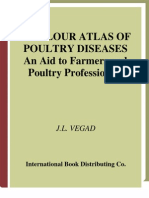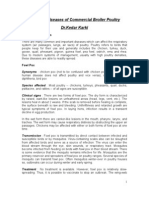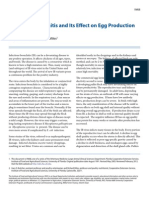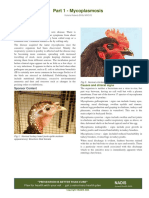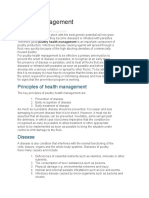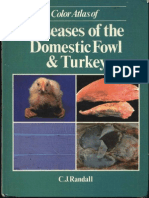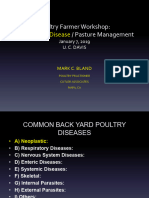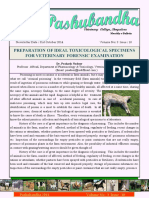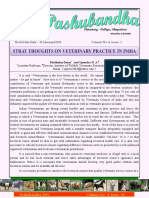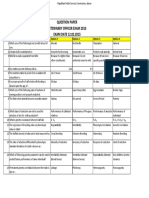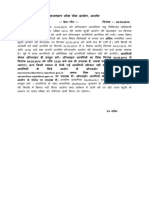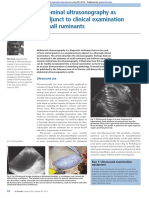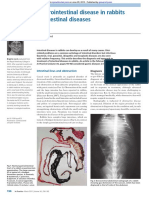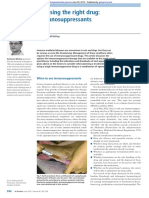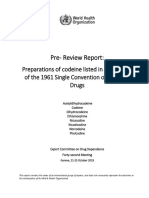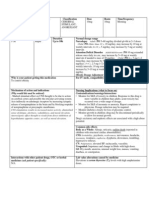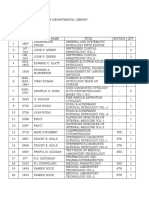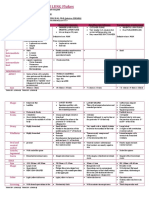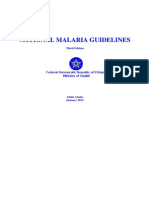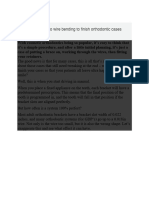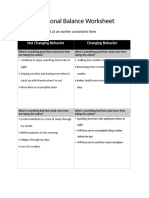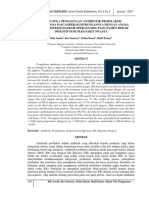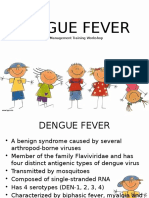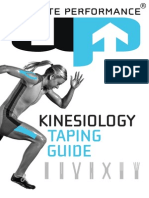Immunosuppression
n Minimize the risk of early exposure to CAV and IBD as much as possible
n Test for seroconversion to CAV before the onset of egg production in all breeder flocks
n proper vaccination programme against IBDV, MD the immunosuppressive diseases
Nutrition
n Ensure proper protein levels for skin strength and feather development
n Avoid excessive energy levels which increases fat deposits and skin fragility
n Make sure diet has biotin which is important for keratin formation
n Provide Vitamin E and Se in young birds to pep up the immune system
n Test for and prevent fat rancidity which can deplete reserves of vitamin E
n Ensure sufficient salt intake to prevent cannibalistic behavior
VOL. 10 NO. 2
Management
n Ensure proper stocking density to prevent skin damage
n Control coccidiosis to prevent stress, malabsorption and secondary nutritional deficiencies
n Implement a lighting program to help control growth rate and activity and to promote
Gangrenous dermatitis otherwise known as wing rot is a consequence of
editorial
immunity
immunosuppression. This effects breeders, boilers and commercial layer. The
n Avoid feed and water outages, loud noises and bird migration which cause crowding Sporadic nature of the disease makes it difficult to understand its contributing factors.
n Ensure adequate ventilation to minimize heat and humidity Thus it is important to document fully each case and understand approaches to limit the
n Maintain good farm hygiene and treat litter as needed. Remove daily mortality as quickly and as problems.
often as possible
Bharat Tandon
FLASH NEWS
It was a memorable event when Mr. Wim Troost, Chairman of Provimi group and Mr. Stoffel Flikweert, Director-
Operations made their glorious presence during the Factory day, the most important event for VETCARE group.
During this special day, the following three new projects were commissioned: Immunosuppression in poultry has number of adverse effects, be it a breeder, broiler or a
1. Amitraz Synthesis Plant: The only one of its kind in India. This unique drug synthesis plant is an attempt at commercial layer. Wing Rot is one of the sequels of such immunosuppression.
backward integration for manufacture of Amitraz B.P. Vet, which is the active ingredient of RIDD. Gangrenous dermatitis which is otherwise known as
2. Research Farm: With the objective to establish world-class research facilities for in vivo testing of various wing rot, blue wing or necrotic dermatitis is a
nutritional formulations in poultry. The research farm carries out publishable studies both within India and bacterial complication with Clostridia sp.,
overseas. Stephyllococcus sp. and E-coli. Most of the
3. Methomin Plant: Deals with biological active minerals chelated minerals bound to specific amino acids. outbreaks in layers occur in 4-16 weeks and also
The plant is to produce chelated minerals for both domestic and global market now. in rapidly growing broilers, those with poor
feathering.
Gangrenous dermatitis (GD) is
characterized by areas of necrosis in the
skin and underlying tissues, usually
The railways developed a unique device to check the strength of the speeding train's windshield. The resulting in death. Any damage to the
device was a gun that launched a dead chicken at the train's windshield at approximately the speed the skin followed by secondary bacterial
train traveled. The logic was that if the windshield didn't crack from the chicken impact, it would infection with Clostridium septicum,
survive a real collision with a bird while running. Clostridium perfringens type A, or
A newly developed high-speed locomotive was to be subjected to this test by the device to test its Staphylococcus aureus, alone or in
windshield. The gun was loaded and was fired, and to the shock of everybody the dead chicken combination, initiates the disease.
shattered the windshield, went through the driver's chair, broke the instrument panel and stuck on to
the back wall of the engine cabin. Immediately an enquiry was ordered to investigate the happening, Clostridia are part of the normal flora
and the enquiry team came up with the recommendation, "Nothing much wrong with the experiment of the chicken gut and are usually
but it would have been better if the chicken used was not frozen". found in soil and contaminated litter.
Published and printed by Bharat Tandon for Vetcare Divn. of Tetragon Chemie Pvt. Ltd., Bangalore. Published from IS-40, KHB Industrial Area,
Yelahanka New Town, Bangalore 560 064. INDIA Ph:91-80-846 2055/56 Printed at Journal House, Bangalore 560 003. Ph:91-80-3463264.
e-mail: vetcare@vsnl.com www.vetcareindia.com
�Staphylococcal bacteria are everywhere; existing on the requires the transfer of sufficient levels of maternal 4) Feed and water outages, loud noises etc. cause the birds
chicken's skin, intestine, and in the chicken house environment. antibody to protect against early field challenge. Never to pile or crowd together and must be prevented by
A sudden, sharp increase in mortality is often the first indication ending Mycotoxins menace & stress contribute to adequate management practices. Also ensures sufficient
of onset. When sick birds are observed, they are depressed and immunosuppression. feeder space and avoid harsh feed restriction programs.
sometimes prostrate or lame. Skin lesions, often crepitant are 5) Heat and humidity: High environmental temperature
apparent in live or dead birds. Mortality varies but can be quite B. Nutrition causes stress and reduces feed consumption (inadequate
high. nutrient intake) which may result in poor feathering and
The following nutritional/feed factors impact the incidence immunosuppression. Excess moisture in the litter
of GD because of their influence on feathering, skin
Lesions promotes bacterial growth. Adequate ventilation and use
strength and immunocompetence: of nipple drinkers can improve environmental
u Dark and gangrenous skin with sloughing and 1. Protein: Both feathers and skin are composed conditions.
feather loss. primarily of protein (keratin). Adequate protein with 6) Farm hygiene: Improved cleaning and disinfecting
u Swelling of parenchymatous organs. an appropriate balance of essential amino acids in the practices, more frequent litter replacement, water
ration will promote adequate feather development and sanitation will decrease the level of bacterial challenge.
u Necrosis of liver.
increase skin strength. Litter acidification has been shown to reduce bacterial
u Severe atrophy of bursa.
2. High energy: High-energy feed (low protein to calorie challenge. Dead birds from GD must be collected
u The subcutaneous tissue with pink or straw- ratio) may marginalize protein intake. Excessive energy minimum of twice per day, otherwise, spores produced
colored fluid and gas (emphysema). in the diets also increases fat deposits in the skin causing by Clostridia in the carcass will result in heavy
increased skin fragility. environmental contamination.
Diagnosis is simple as one cannot miss the lesions. However, 3. Vitamin E & Se: A sufficient level of vitamin E & Se is Antibiotics that have been found effective are penicillin
there are many similarities between GD and cellulitis. Both important for development of the immune system and erythromycin, tetracycline, lincomycin, chloram-phenicol
diseases are produced by bacterial infection secondary to skin also protects the birds' cells against oxidative etc. Vit E and Selenium are found to be useful in reducing the
damage and occur more frequently following compounds (originated from rancid fat or tissue severity and mortality.
immunosuppression. The primary difference being the type of damage. Efforts to prevent GD should be focused on limiting the level
bacteria causing the infection (E. coli in the case of cellulitis).
4. Fat rancidity: Use of rancid fat will cause increased of bacterial challenge, boosting immune system function,
Therefore, many of the preventive measures are the same for
utilization of vitamin E (through oxidation) and rapid and minimizing the possibility of wounds and/or scratches to
both diseases.
feed transit (therefore, decreased nutrient uptake). If the skin through nutrition and management factors.
you are using oils in feed ensure to blend the feed with
good antioxidant.
TREATMENT
5. Salt: Insufficient salt in the feed may lead to hysteria
Factors influencing the GD incidence:
and increased cannibalistic behavior. Gangrenous dermatitis continues to be a significant health
GD can occur in all breeds and breed crosses. Two determining problem for layers as well as broilers. Its sporadic nature can
factors that may be associated with the contraction of GD are make determining the contributing factors difficult.
sex and breed type. In feather sexable breeds, the slow- C. Management
Therefore, it is important to fully document each case for
feathering broiler males may be more vulnerable to skin injuries Numerous management factors as described below can
better understanding of the factors
due to a longer period of exposure prior to feather coverage also influence the occurrence of GD by an increased risk of
than females, which are fast feathering. Also, male broilers may involved. Key approaches to limit the
skin wounds and/or additional bacterial challenge.
have a higher frequency of GD because they gain weight faster, problem should include improved
1) Stocking density: High density is directly correlated to control programs for CAV, IBDV
are heavier and are more aggressive than females, although the
increased skin damage.
females have more fragile skin. and coccidiosis; improved farm
2) Coccidiosis control: Adequate control is important as hygiene; concentration on
coccidiosis causes stress, immunosuppression, management factors, particularly
A. Immunosuppression malabsorption, and secondary nutritional deficiencies.
nutrition, stocking density and
As stated previously, it is well documented that impaired Coccidiosis may induce vitamin E deficiency by
lighting programs and improved
function of the immune system will contribute to an increase in interfering with absorption and causing increased
control of environmental conditions.
the incidence of GD. Many viral agents can affect the immune utilization due to oxidation caused by damage of the
system, with both CAV and IBDV being particularly harmful. intestinal cell walls.
Significant immunosuppression may occur if birds are exposed 3) Lighting programs: These are important for
to CAV early in life or infected through vertical transmission. controlling growth rate and reducing bird activity.
Also, chicks lacking maternal immunity are more susceptible to Lighting programs can help to reduce excitability,
clinical disease and immunosuppression. Control of IBDV physiological stress and improve immunity.







